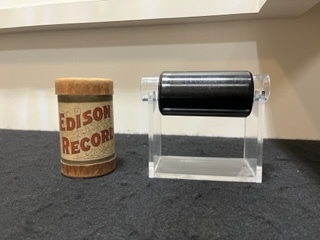Cylinders
The brown wax cylinder used for audio playback was created in conjunction with Thomas Edison's phonograph in the late 1800s. Edison experimented with materials such as paraffin paper, tin foil, and cardboard before eventually discovering wax to be the best medium for his machine. After they were mass marketed in the late 1880s, brown wax cylinders improved over time in quality and durability due to advancements in the type of wax used. These improvements led to the release of new cylinder lines such as the Gold Moulded and Blue Amberol Edison Records, which ultimately expanded the lifespan of this type of media.
After the initial introduction of wax cylinders, the production of celluloid cylinders, such as the Blue Amberol cylinder pictured below, began in 1900. They were very successful on the market due to their long-lasting sound quality and the durability of the hard plastic material. Eventually, disc records began to dominate the market, and cylinders ceased production in 1929, coinciding with the closing of Edison records.



